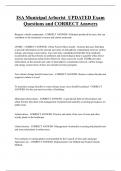ISA Municipal Arborist UPDATED Exam
Questions and CORRECT Answers
Biogenic volatile compounds - CORRECT ANSWER- Pollutants produced by trees, that can
contribute to the formation of ozone and carbon monoxide
UFORE - CORRECT ANSWER- Urban Forest Effects model - Systems that uses field data
to provide information on the amount and value of atmospheric contaminant removal, carbon
storage, and energy conservation. Uses real-time, standardized field data from randomly
located plots and local hourly air pollution and meteorological data to quantify urban forest
structure and numerous urban forest effects for cities across the world. UFORE provides
information on the amount and value of atmospheric contaminant removal, carbon storage,
and energy conservation. If does not include inventory program.
Two climate change benefits from trees - CORRECT ANSWER- Remove carbon dioxide and
sequester carbon in wood
To maximize energy benefits in warm climate areas, trees should be planted - CORRECT
ANSWER- On the east and west sides of buildings
Municipal arboriculture - CORRECT ANSWER- A specialized field of arboriculture and
urban forestry that deals with management of planted and naturally occurring greenspaces on
public land.
Arboriculture - CORRECT ANSWER- Practice and study of the care of trees and other
woody plants in the landscape.
Urban forestry - CORRECT ANSWER- Management of naturally occurring and planted trees
and associated plants in urban areas.
Two methods of valuing plants recommended by the Council of Tree and Landscape
Appraisers are - CORRECT ANSWER- Replacement Cost Method and Trunk Formula
Method
,Reasons a community may place a priority on tree preservation during land development -
CORRECT ANSWER- important environmental and social functions, added property value,
community demands tree preservation, trees may be part of larger resource conservation
program
Five management improvements needed to achieve urban forest sustainability - CORRECT
ANSWER- improved tree inventory implementation, analysis, assessment, and integration;
improved dialog and collaboration among agencies, tree owners, and managers; improved
understanding of the relationship between forest configuration and benefits; improved
knowledge of the factors affecting forest health; improved information transfer
Key functions of the municipal arborist - CORRECT ANSWER- Providing expertise in the
condition and function of the urban forest; coordinating other professionals and technical
information; overseeing preparation of the document; acting as contract administrator;
gathering applicable resource information; formulating goals and action items; preparing or
contributing to written document
Information the municipal arborist should provide to help facilitate development of an urban
forest master plan - CORRECT ANSWER- Description and evaluation of the urban forest;
evaluation of infrastructure conflicts; description of department structure, budget, funding
sources, operations, staffing; description of interaction with municipal departments and
related community groups
Agents of change - CORRECT ANSWER- Factors that influence the dynamics of the
vegetation over time. E.g. environmental agents (air pollution and pests), public agents
(ordinances and tree boards), Private agents (news media and land developers)
Major components of a comprehensive street tree management plan - CORRECT ANSWER-
Identify locations and sequence of planting to optimize tree cover; identify tasks to be
preformed and their priority for allocation of funds; tree replacement policy to when trees
will be removed and replaced; actions to create a wide range of species and ages;
information-education program between public and agency; how to incorporate agents of
change that arise over time to accomplish goals
Municipal arborists' role in meeting criteria for urban forest sustainability - CORRECT
ANSWER- Providing expertise and action in selecting, installing, and maintaining new trees,
and preserving and maintaining existing trees; providing expertise and outreach to the
community and green industries; adopting and adhering to professional standards for tree care
, In developing an urban forest master plan, the vegetation that should be considered includes -
CORRECT ANSWER- Street trees, parks, greenbelts. NOT ecological preserves or
residential gardens
Examples of comprehensive goals of an urban forest management plan - CORRECT
ANSWER- Defining the percentage of canopy cover; policies for risk management versus
tree removal, and encouraging public participation
Work plan time frame - CORRECT ANSWER- Immediate (1-2 years)
Master plan time frame - CORRECT ANSWER- Long range (>10 years)
Management plan time frame - CORRECT ANSWER- Short term (3-5 years) or intermediate
(5-10 years)
Successful tree preservation requires __________ for adequate __________ for tree root and
crown development and function. - CORRECT ANSWER- planning and space
Tree inventory - CORRECT ANSWER- Data are collected about individual trees within a
population. The data usually includes species, size, health, structural condition, location, and
maintenance requirements.
Natural resource inventory - CORRECT ANSWER- Assessment is done on a group level
(rather than for individual trees). The data usually includes stand density, age distribution,
and species composition, as well as associated vegetation, fauna, and ecological and
geological features often are included.
i-Tree - CORRECT ANSWER- Software tool that links STRATUM, UFORE, and MCTI. i-
Tree allows communities to analyze the costs, benefits, and management needs of their urban
forest using integrated computer tools. i-Tree can be used within a community to compare
and contrast the cost and benefits of different tree species, sizes, and life span. i-Tree is
different from commercial tree inventory software in that it uses USDA Forest Service
software to analyze costs and benefits of the urban forest.
MCTI - CORRECT ANSWER- Mobile Community Inventory Tool




